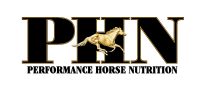SUPER FIBERS
-the benefits for horses-
SEPTEMBER 2018

Written by Performance Horse Nutrition
Plants contain fibrous material known as structural carbohydrate. The primary structural carbohydrates include cellulose, hemicellulose, and lignin. These fibrous carbohydrates play an important role in providing plants with their structural rigidity allowing them to grow upright. However, because of their complex chemical structure, they are difficult to breakdown and digest. The horse does not produce the necessary enzymes to break down and digest these complex carbohydrates. Instead, the horse relies on microbes in the hindgut to ferment and break down these carbohydrates.
Total structural carbohydrate content of a plant is represented on a laboratory analysis report as Neutral Detergent Fiber (NDF). Neutral Detergent Fiber is a measure of the hemicellulose, cellulose and lignin content of a plant. Not all fibrous carbohydrates are digested with the same efficiency. Hemicellulose is more readily digested than cellulose, while lignin is completely indigestible by both the horse and microbes.
What is a Super Fiber?
A super fiber is a product that contains a significant amount of structural carbohydrate (NDF) with only small amounts of lignin or non-digestible fiber. Common examples of super fibers utilized in horse feeds include: beet pulp and soybean hulls. These super fibers will have approximately the same amount of structural carbohydrate as hay, but with significantly less lignin. This makes these super fibers much more digestible and ultimately more useful to produce energy (calories) for the horse. In essence, super fibers are safe to feed like hay, but actually contain a calorie value closer to oats. Super fibers do not have the negative health consequences of grains. For example, feeding too much grain in a single meal can result in colic or laminitis. Feeding too much fiber does not produce these consequences. Horses that are offered too much super fiber will gain weight over time, not colic or develop acute laminitis.
What Type of Horse Could Benefit from Super Fibers?
Performance horses are the leading candidates to be fed super fibers. Meeting the high calorie (energy) demands of a working horse is a balancing act. If we feed too much sugar/starch containing grain we risk digestive upset, laminitis, ulcers and potential erratic behavior. To safely fuel the calorie requirements of these horses we want to incorporate super fibers into the grain mix. These super fibers will provide the same amount of calories as grain, but as a high calorie fiber. Performance horse diets also utilize oils to further avoid digestive upset and laminitis that may occur if grains are overfed.
Underweight horses are also a group that benefits from the addition of super fibers in the diet. Many horses that are underweight are very sensitive to large amounts of grain in the diet. However, by incorporating super fibers we can provide the necessary calories for weight gain as a highly digestible fiber. Senior horses can also benefit from super fibers in their diet. Many older horses have incomplete dentition in the form of poor or missing teeth. These horses still require fiber in the diet like all horses, but they do not have the ability to proper chew and swallow hay. By providing a diet that is pelleted, and includes super fibers these horses get the necessary fiber in an easy to chew and swallow physical form plus the additional calories necessary to maintain weight.
The last groups of horses that benefit from super fibers in the diet are carbohydrate sensitive horses. Super Fibers including beet pulp and soybean hulls are very low in sugar and starch. They are certainly much lower in sugar and starch compared to grains. In addition, super fibers are lower in sugar and starch even compared to cool-season grass hays (orchard grass, timothy grass). Super Fibers are a great feeding tool to provide necessary fiber to these carbohydrate sensitive horses without providing an abundance of sugar.
-Dr. Stephen Duren, Performance Horse Nutrition

